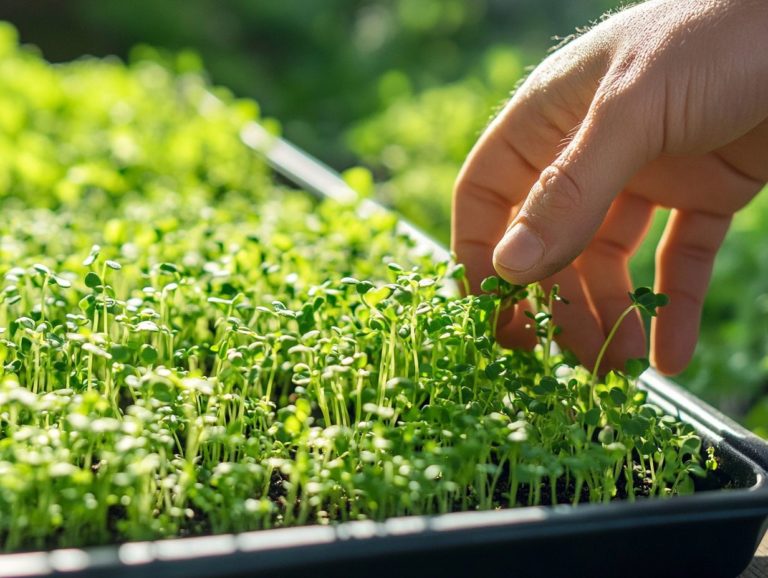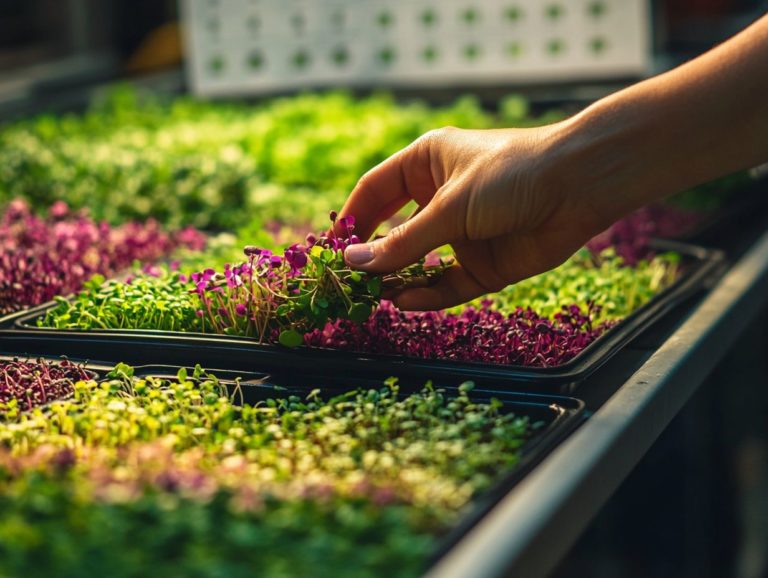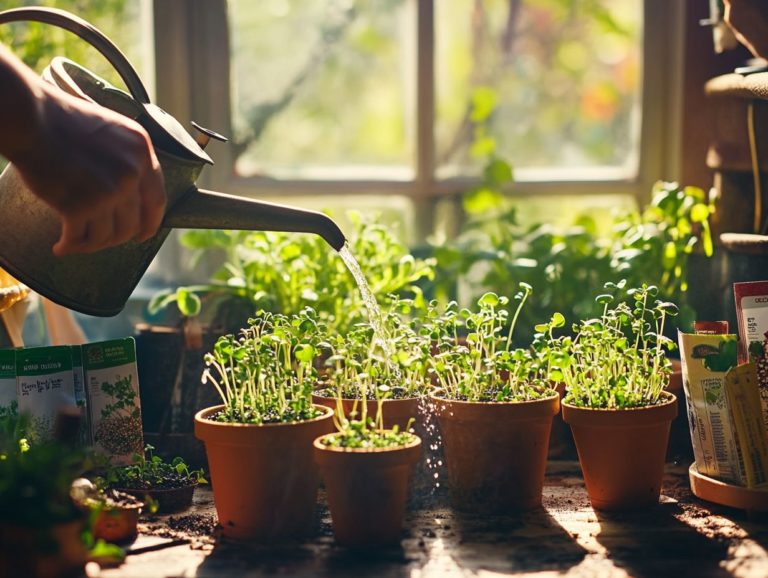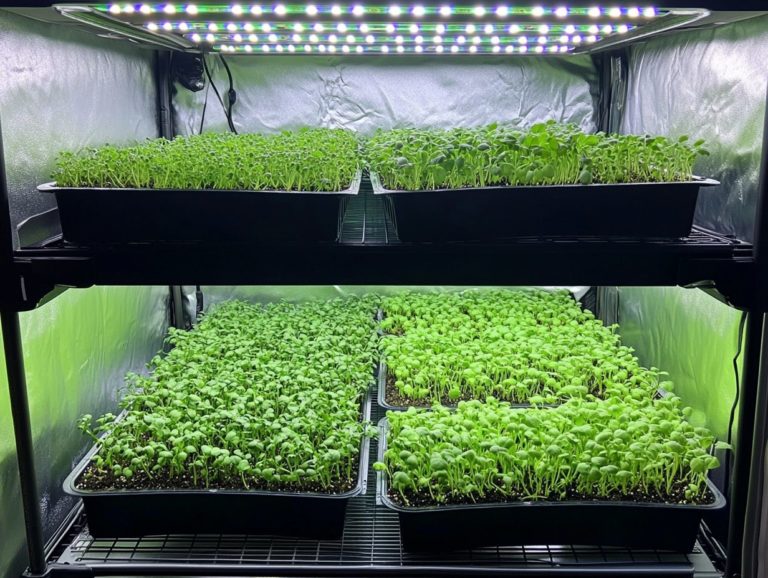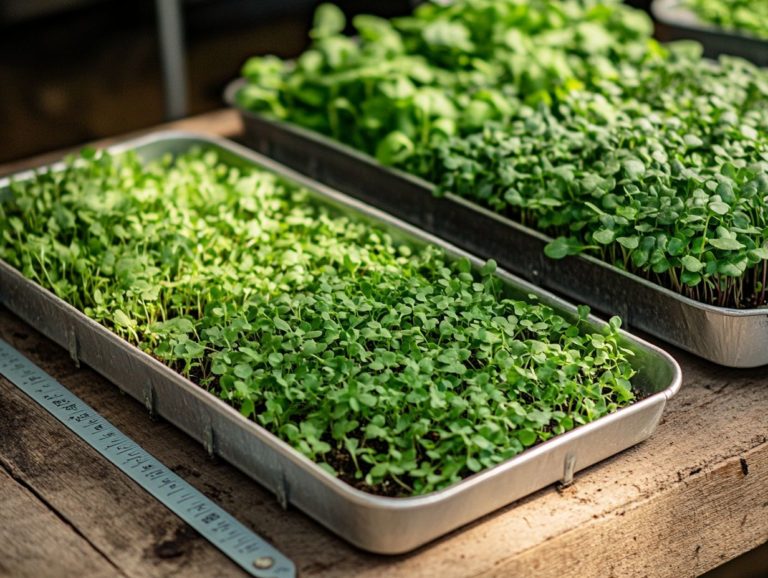The Science Behind Microgreen Growth
Microgreens are exquisite, nutrient-dense plants that have captured attention in the culinary world. They have striking colors and bold flavors that transcend the role of mere garnish.
This article invites you to explore the wonderful world of microgreens, examining their growth process and the myriad factors that influence it. You will uncover the advantages of cultivating these vibrant greens, compare various growing methods, and tackle the common challenges that growers encounter.
Immerse yourself in this exploration and discover how these petite powerhouses can create a significant impact!
Contents
Key Takeaways:

- Microgreens are young, edible greens packed with nutrients.
- They can be grown indoors or outdoors.
- Growing microgreens provides a sustainable food source.
What are Microgreens?
Microgreens are young, edible plants harvested just after the first true leaves emerge, which are the leaves that develop after the initial sprout, indicating healthy growth. You may have noticed their rising popularity as a health-enhancing addition to diets, thanks to their impressive nutritional benefits, which boast a wealth of vitamins, antioxidants, and phytochemicals.
In the culinary realm, microgreens are often celebrated for their vibrant colors and bold flavors. They have become a staple in high-end restaurants and play a key role in food innovation and sustainability.
Their allure extends beyond taste; these superfoods also offer potential health benefits and play a vital role in combatting malnutrition.
Definition and Characteristics
Microgreens are the young seedlings of vegetables and herbs, harvested at their prime, usually within 7 to 21 days post-germination.
These tender greens not only captivate the eye with their vibrant hues but also impress with their exceptional nutrient density, often surpassing their mature counterparts in vitamins and minerals. The flavor profiles can be a delightful surprise; some offer a mild taste, while others deliver a zesty, peppery punch, adding an exciting twist to your dishes.
Beyond their nutritional prowess, these petite greens also elevate culinary experiences with their crisp textures and enchanting aromas. They are a favorite among chefs looking to enhance salads, sandwiches, and garnishes. This remarkable blend of attributes distinguishes microgreens from other greens, positioning them as a versatile ingredient in contemporary cooking. Furthermore, understanding the science behind microgreens and health can deepen appreciation for their benefits.
How Do Microgreens Grow?
The growth of microgreens captivates with its intricate stages, beginning with germination the process where seeds begin to grow and culminating in harvest. This fascinating journey typically spans 7 to 21 days, influenced by both the species and the specific growing conditions you provide.
Germination and Growth Process
Germination marks the first crucial phase in the growth of microgreens. During this stage, seeds eagerly absorb water and begin their journey of sprouting, typically under carefully curated conditions of light and moisture.
During this foundational stage, it’s vital to maintain consistent temperature and humidity levels. An environment of around 70-75 F paired with 50-70% humidity provides the perfect setting for optimal sprouting. The light spectrum is equally important; employing grow lights that emit a balanced mix of red and blue wavelengths can significantly boost growth. For more detailed information, check out our guide on understanding light needs for microgreens.
By controlling these factors with precision, you support the sprouting process and influence the final nutrient profile of your microgreens.
For example, ensuring adequate light exposure can elevate the levels of beneficial compounds like vitamins, antioxidants, and chlorophyll, resulting in a more nutritious product.
Factors Affecting Microgreen Growth
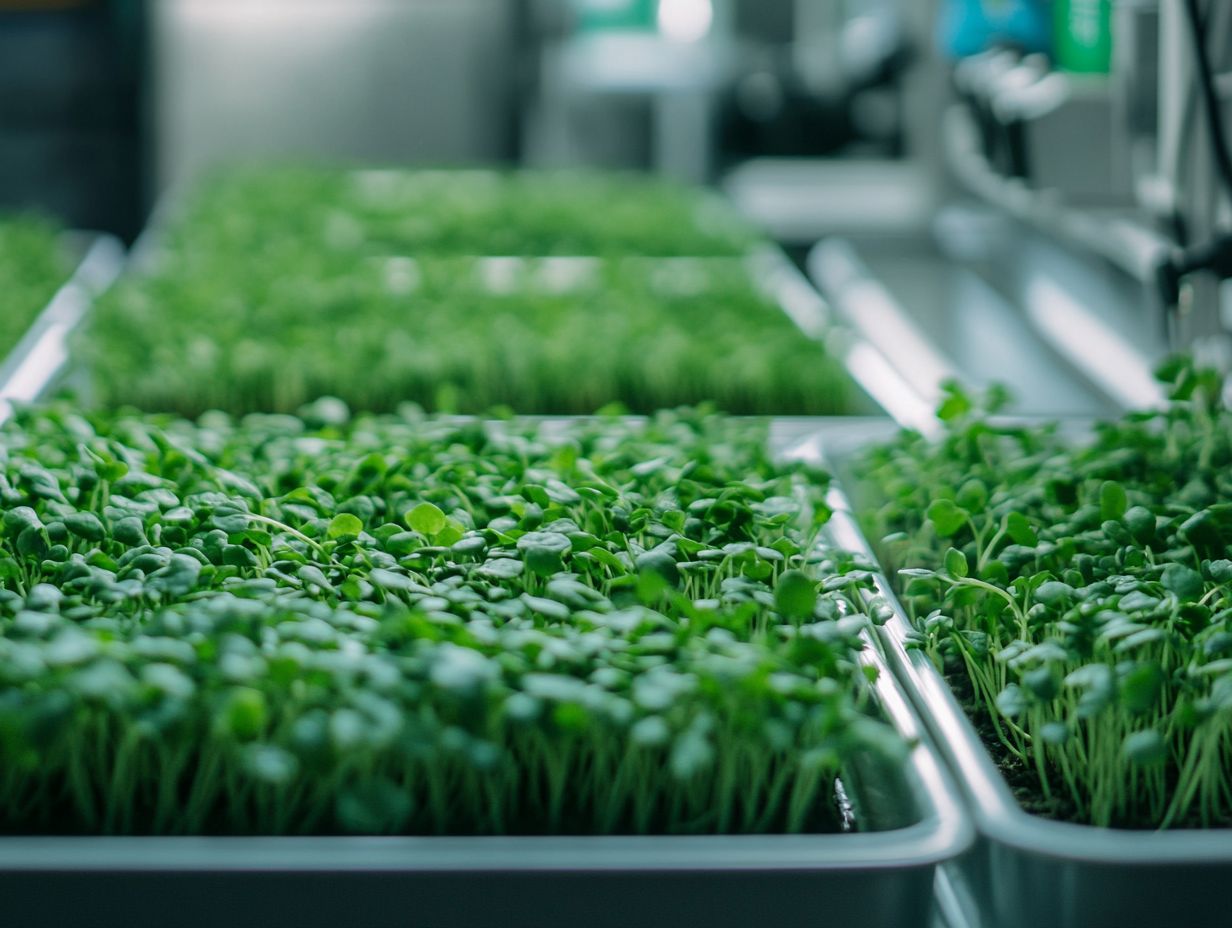
A variety of factors significantly influence the growth of microgreens, including light exposure, water availability, and nutrient requirements. These elements work in harmony to enhance their overall health and nutritional value, ensuring that your microgreens flourish beautifully.
Start your microgreen journey today and experience their amazing benefits firsthand!
Light, Water, and Nutrient Requirements
Light is essential for the healthy growth of microgreens, as it fuels photosynthesis. Adequate water and balanced nutrients are crucial for optimal germination and growth.
The interplay of these factors plays a significant role in determining the quality and yield of your microgreens. If you skimp on light, you might end up with elongated stems and weak foliage. Conversely, too much light could lead to unsightly leaf burn.
The right amount of water promotes robust root systems and helps you avoid issues like damping off, a common threat to young plants.
Nutrient-rich soil is your ally, providing essential minerals that encourage rapid growth and enhance flavor profiles. Balance light, water, and nutrients to cultivate vibrant, flavorful microgreens. If you encounter challenges, refer to troubleshooting common microgreen growth issues to help them thrive in various environments.
Benefits of Growing Microgreens
Growing microgreens presents a wealth of advantages, from their remarkable health benefits to their significant contributions to food security and prevention of malnutrition.
Incorporating these nutrient-dense plants into your diet elevates your meals and enhances your overall well-being while supporting diverse dietary choices.
Nutritional and Environmental Benefits
People rave about microgreens for their amazing health benefits! They boast a remarkable nutritional profile, packed with vitamins, minerals, and antioxidants that enhance your overall health.
These tiny greens are rich in vitamins A, C, E, and K, along with essential minerals like calcium and magnesium. This combination delivers an impressive nutritional punch. For instance, vitamin C gives your immune system a delightful boost, while vitamin K plays a vital role in maintaining bone health. Understanding microgreen growth cycles can further enhance the benefits of these greens. The antioxidants in microgreens work to combat oxidative stress, potentially reducing the risk of chronic diseases.
Cultivating microgreens is an environmentally conscious choice. They thrive in small spaces and require minimal resources, significantly cutting down the need for harmful agrochemicals. This approach fosters biodiversity and champions sustainable agriculture by minimizing the carbon footprint often linked to traditional farming methods. To maximize your efforts, consider understanding microgreen growth rates, which can enhance your cultivation techniques.
Methods for Growing Microgreens
You have a variety of methods for cultivating microgreens. Whether you choose soil-based or hydroponic systems, there are options for both indoor and outdoor growing practices.
Each approach caters to different consumer preferences and adapts to various growing conditions, allowing you to select the best fit for your needs.
Soil vs. Hydroponic Growing
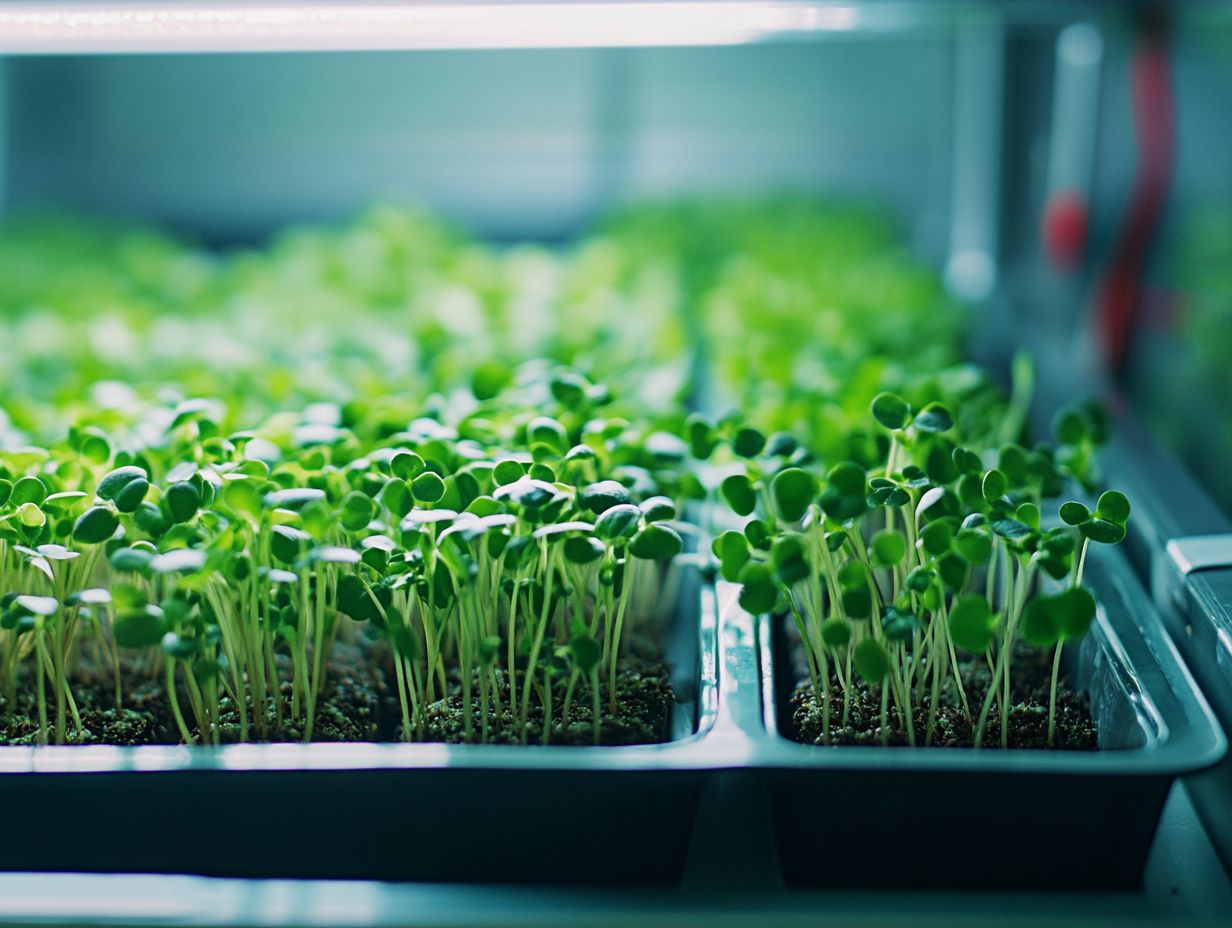
The choice between soil and hydroponic growing methods for microgreens can significantly impact their nutrient composition, flavor, and overall growth success. This decision often depends on your available space and experience level.
Soil nurtures a diverse community of tiny organisms that help plants grow, enhancing nutrient uptake and contributing to unique flavor profiles. Hydroponic systems, however, offer a controlled environment where plants receive precisely balanced nutrients directly in water, often resulting in faster growth rates and higher yields. For those interested in growing microgreens, understanding microgreen harvest timing can further improve your results.
Understanding these differences is essential for anyone interested in cultivating microgreens. For deeper insights, check out understanding microgreen growth phases. They influence not only the growth speed but also how the plants interact with their nutrients, ultimately shaping their taste and nutrient density.
Indoor vs. Outdoor Growing
Choosing between indoor and outdoor cultivation for microgreens hinges on several key factors, including your climate, available space, and the level of control you desire over growing conditions.
When you opt for an indoor environment, you gain the advantage of consistency. This allows you to manage variables such as temperature and humidity with precision, leading to faster germination and healthier plants. Using sprouting trays for microgreens in a controlled setting shields your plants from pests and diseases, significantly boosting your yields while minimizing risks.
Conversely, outdoor cultivation harnesses the power of natural sunlight, offering a cost-effective method to encourage robust growth. For those interested in maximizing their yields, understanding the growth patterns of microgreen varieties can be beneficial. However, this approach does expose your crops to unpredictable weather and pesky intruders.
Ultimately, grasping these dynamics gives you the power to choose the growing method that best aligns with your goals and environmental circumstances. This choice influences not only your personal journey but also broader food systems and sustainability.
Common Challenges in Microgreen Growth
Growing microgreens is fun and rewarding! Yet, you may encounter various challenges along the way.
Pest infestations, diseases, and other growth obstacles can emerge, potentially hindering your success.
Pests, Diseases, and Other Obstacles
Pests and diseases present significant challenges to the health of your microgreens. Careful monitoring and management are necessary to ensure their successful growth and optimal nutritional composition.
Common culprits like aphids, whiteflies, and downy mildew can compromise the delicate structure of your young plants. To tackle these issues, consider a plan to control pests naturally, emphasizing prevention and using beneficial insects like ladybugs or lacewings.
Regular inspections, proper ventilation, and maintaining adequate moisture levels can help minimize disease outbreaks. When necessary, organic fungicides can be utilized to safeguard against fungal threats. Additionally, using natural fertilizers for microgreen growth can enhance your efforts. By understanding these challenges and implementing effective strategies, you can cultivate vibrant, nutrient-packed microgreens that thrive.
Frequently Asked Questions
What are microgreens and how do they grow?
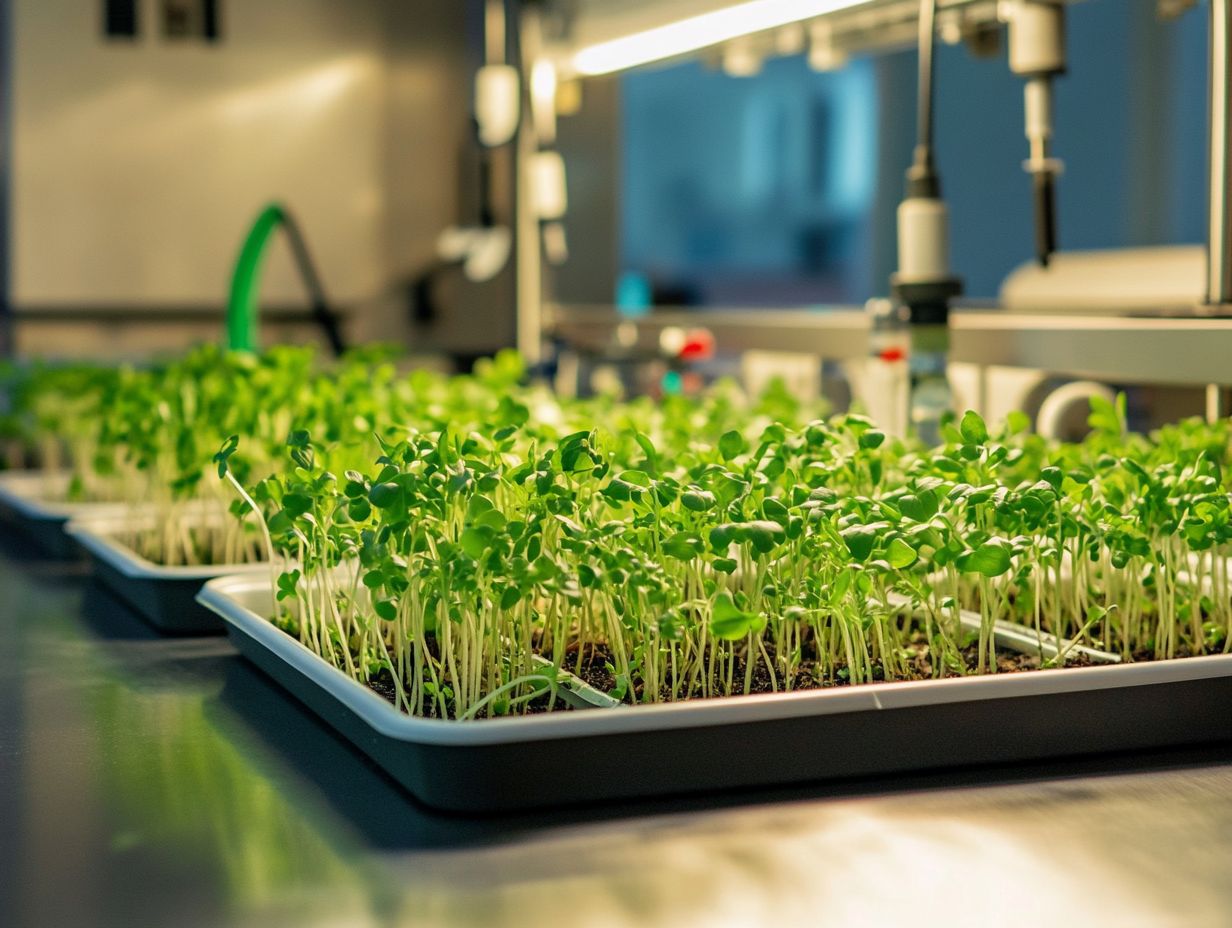
Microgreens are young vegetable greens harvested after sprouting but before they become baby plants. They can be grown from a variety of seeds and are typically harvested within 7-14 days after germination.
How do microgreens grow?
Microgreens grow through photosynthesis, where they absorb light energy to convert carbon dioxide and water into glucose, their main source of energy. This process is facilitated by chlorophyll, which gives the microgreens their green color.
Do microgreens need special conditions to grow?
Yes, microgreens require specific conditions for optimal growth, including a warm and moist environment, adequate air circulation, and proper lighting. The type of seed used and the quality of the soil also play a crucial role.
How long does it take for microgreens to grow?
The growth time varies depending on the type of seed, but most microgreens are ready to harvest within 7-14 days after germination. Some microgreens, such as broccoli and radish, can be harvested as early as 5 days after germination.
What are the benefits of growing and consuming microgreens?
Microgreens are packed with nutrients, including vitamins, minerals, and antioxidants that are beneficial for overall health. They are easy to grow and can be cultivated year-round, making them a cost-effective and sustainable source of fresh produce. Studies have shown that microgreens may have anti-inflammatory and cancer-fighting properties.
Can anyone grow microgreens at home?
Yes, anyone can grow microgreens at home with the right tools and knowledge. They require minimal space and can be grown in trays, pots, or even recycled containers. Various online resources are available for beginners to learn how to grow microgreens at home.
Ready to grow your own microgreens? Don t miss out on the amazing benefits of growing your own microgreens today!

